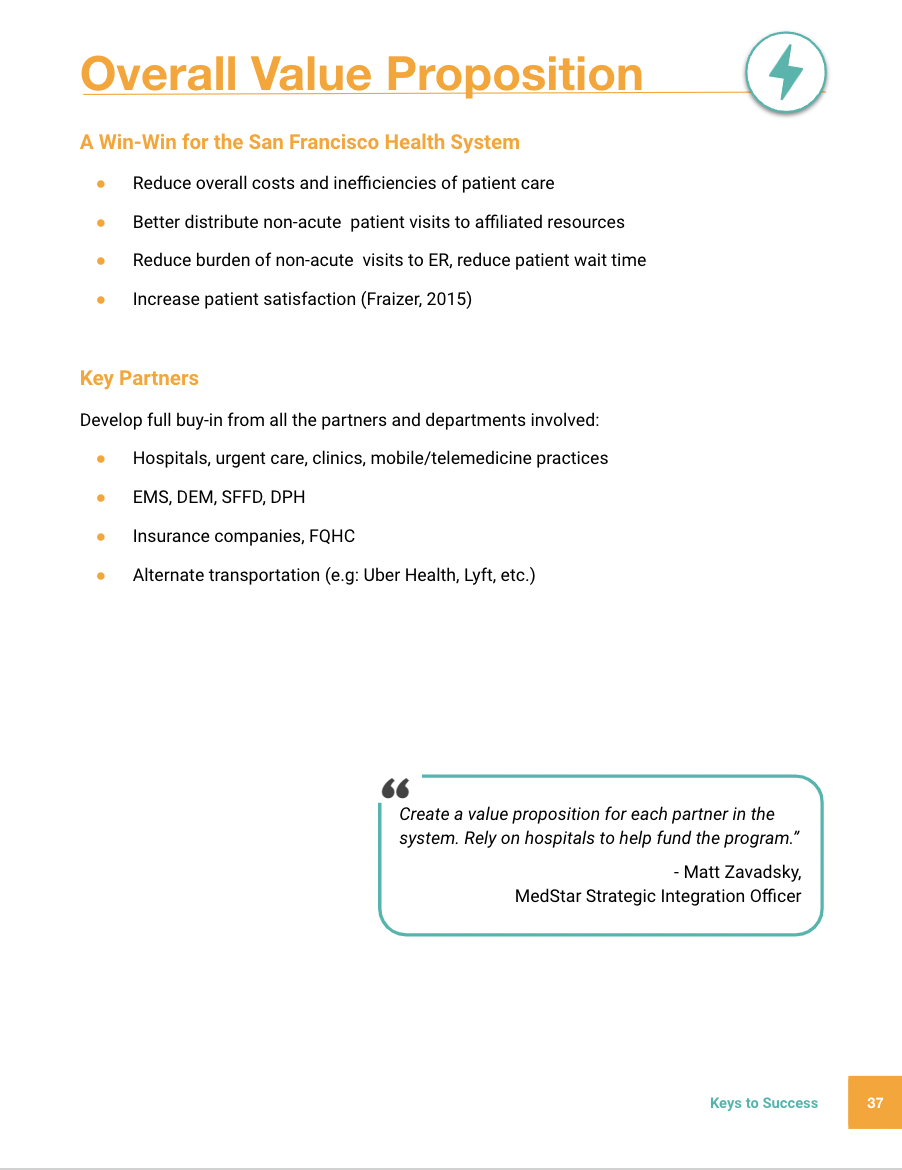911 Alternative
Design Research · Workshop Facilitation · Systems Design · Stakeholder Alignment
Duration: 6 month consulting project
Role: Design Strategist & Lead Primary Researcher (team of 5)
Location: San Francisco, CA
Client: the San Francisco Department of Emergency Management (DEM) partnered through San Francisco’s Civic Bridge program to explore alternative ways to address non-acute emergency calls for San Francisco’s 911 system.
Project completed through Cosine Collective, a non-profit led by the MBA in Design Strategy community at California College of the Arts. We help organizations solve problems so that they can better meet the needs of the communities they serve.
Challenge statement
Exploring alternative solutions to address non-acute medical 911 calls in SF for more effective patient care and more efficient use of 911 department resources.
Discovery
Civic Bridge kicked off our cohort of projects with a daylong orientation and workshop where we met our client, Robert Smuts, the Director of SF’s Department of Emergency Management (DEM).
Together we mapped out the current 911 system, pain points, and opportunities to further explore.
Once we understood that DEM was experiencing an increase in call volume and, therefore, a stress on emergency services, we started to explore how other cities have dealt with the same issues, including a nurse-triage system.



Primary research
I led primary research which included:
sitalongs with 911 call takers & dispatchers to understand their workflow and pain points
interviewing ten 911 department leaders & stakeholders
facilitating design workshop exercises with 911 department leaders & stakeholders
Insights
911 call takers work a high-stress job with high turnover, varying levels experience, and insufficient training (currently only receiving onboarding training)
steep learning curve of CAD systems with archaic user interface requiring command inputs; are there alternatives to their current software which include nurse triage?
call taker buy-in, training, and adoption will be key for the implementation of a new system
alignment with 911 fire department’s existing programs of outreach to the unhoused community for prevention services via EMS 6 unit
Comparative case studies
We explored emergency nurse triage systems in cities both internationally and in the US, focusing on Fort Worth, TX, Washington DC and Reno, NV.
The nurse triage system allows for non-acute medical 911 calls to be redirected to more care options, besides just sending an ambulance. The nurse assesses the caller’s symptoms over the phone and can:
dispatch an ambulance if it is deemed an acute medical emergency,
connect the patient with alternative transportation to the care provider,
book an appointment with an appropriate care provider (e.g. urgent care, community clinic, dentist, etc.)
provide nurse advice for self care / home care
or share other resources with the patient




Results
Through our conversations with other cities, we developed a VCAP, a User Journey Map and a resource tree for San Francisco. These tools helped us conclude that a nurse triage system that is integrated with the current 911 call center would be effective for San Francisco. We found that the nurse triage system reduces strain on emergency responders, as well as increases patient satisfaction.
Internal stakeholders were enthusiastic about using the nurse triage system because it is a better way to allocate limited emergency resources for those experiencing life or death emergencies. This approach can potentially be very effective for San Francisco because it has a number of alternative care options such as urgent care centers and primary care providers.
The success of nurse triage program in other cities depended on their network of medical care options and alternative transportation resources such as Lyft or Uber. Moving forward, San Francisco DEM will need to work extensively with these transportation resources to build a network of alternative care for people with non-acute emergencies who call 911.
Next steps are for San Francisco DEM to engage city stakeholders to create interest and support for this program. Cosine Collective has started the process of identifying these key stakeholders and developing materials to communicate the proposed nurse triage system with them. We see great opportunities to collaborate with the city in advocating for such a beneficial program.







